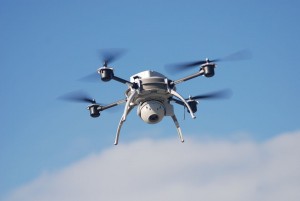After having had such fun with the Structure Sensor I borrowed through the N.C. State Libraries Technology Lending program, I suggested that they consider lending quadcopters like the DJI Phantom 3. Drones like the Phantom 3 are so cutting-edge that they are far ahead of Federal Aviation Administration regulations, so much so that many common-sense uses of drones (or as the FAA calls them, “unmanned aircraft systems” or UAS) are currently banned outright.
Like other university libraries, N.C. State Libraries would love to lend out drones but the present legal limbo with the FAA prevents that from happening. You see, what many people don’t realize is that the FAA is in charge of the nation’s airspace from the ground up. Not just 500 feet and above but starting at the ground. Public property, private property, it doesn’t matter. If you fly anything, anywhere, the FAA makes the rules.
And the FAA takes its rules very seriously. They’ve been known to scour YouTube and contacting drone operators who’ve been violating Federal law (though they’ve since stopped the practice). The easiest way to do this is to fly a drone for commercial work. Under the current rules, any commercial flying requires a full-blown pilot’s license. Yes, the kind you spend thousands of dollars to obtain. Only personal use (“hobby and recreational”) is currently allowed. And all flights are restricted to stay below 400 feet above ground.
The FAA was obviously caught off guard by the lightning-fast appearance of tiny, sophisticated flight platforms anyone can afford. FAA regulations meant to cover manned, fuel-laden aircraft weighing thousands of pounds are ill-suited for battery-powered, unmanned drones weighing 5 pounds or less. Aircraft this small are impossible to see on radar (whether below 500 feet or above), leaving the FAA with few tools for enforcement. It sounds like the proposed new rules might be its best opportunity to get some kind of regulation in place.
The proposed new rules were published for comment in February and, from what I’ve read, appear to be quite reasonable. Until they take effect, however, drones that universities hoped to lend to their members are likely to remain grounded.
